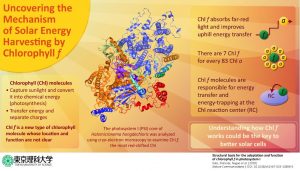Scientists have discovered a new type of chlorophyll molecule which can allow solar cells to function better than ever before.
The process which allows plants and other organisms to convert sunlight into chemical energy, photosynthesis, is a complex phenomenon involving a myriad of proteins.
The molecule Chl f, a newly discovered type of chlorophyll, is known to play a part in photosynthesis, but owing to its recent discovery, its location and functions are not understood. Scientists from Japan have now analysed in detail the protein complex involved in photosynthesis and uncovered several new aspects about Chl f.
Some organisms, such as plants, cyanobacteria, and algae, are capable of directly converting this light energy into chemical energy via a process called “photosynthesis”. These photosynthetic organisms contain special structures to mediate photosynthesis, called “photosystems.”

There are two photosystems that carry out light–energy conversion reactions, each of which is composed of several proteins and pigments. Among photosynthetic pigments, chlorophyll is the most crucial one, which not only captures light energy from the sun but also participates in the “electron transfer chain”, a molecular pathway through which photons (from the sunlight) are converted into electrons (which are used as an energy source).
There are different types of chlorophyll molecules, each having a specific function ranging from absorbing light and converting it into energy. Moreover, each chlorophyll molecule absorbs light in different regions. Recently, a new type of chlorophyll called Chl f was discovered, but details like exactly where it is located and how it functions have remained a mystery until now.
In a new study published in Nature Communications, a team of researchers led by Professor Tatsuya Tomo at the Tokyo University of Science, Japan, and including collaborating researchers from multiple institutes, revealed new details about the location and functions of Chl f.
The research team wanted to gain insight into the complex process of photosynthesis, as an in-depth understanding of this process could have various future applications, such as using chlorophyll to help solar cells function more efficiently.
Tomo says, “The initial course of photosynthesis begins when the photosynthetic pigment bound to this photochemical complex absorbs light. We analysed the structure of a newly discovered photochemical complex, photosystem I with Chl f that has an absorption maximum on the lower energy side of light (far-red light). Moreover, we analysed the function of Chl f.”



